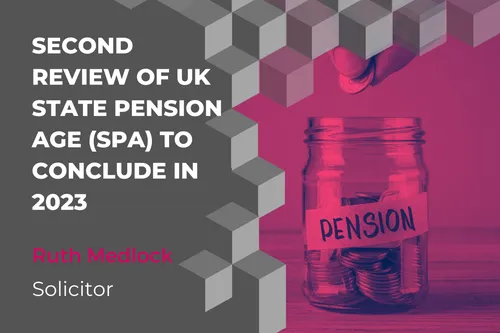
After months of speculation in 2022 about the anticipated increase to the UK’s SPA from 66 to 67 by 2028, the Department of Work and Pensions (DWP)’s second review of the SPA is set to conclude this year. Laura Trott MP (Pension Minister) has recently written to the Chair of the Work and Pensions Committee to confirm that we should expect to receive the Government’s independent reports ‘no later’ than the Government’s own pension report.
The second review will conclude in 2023 and is set to deliberate on whether the SPA rules are ultimately fitting to the varying life expectancies (and subsequent pension inequalities) across the nation.
As mentioned above, the UK’s current state pension age is 66 years of age. However, there are two expected increases to this – a rise to 67 by 2028 for those born on or after April 1960 and a subsequent rise to 68 between 2044 and 2046 for those born on or after April 1977.
The potential controversy in the Government increasing the state pension age is that doing so could arguably place certain individuals on unequal footing financially. Whilst the idea behind having an SPA is an attempt to ensure the receipt of state pensions is somewhat fair, there is an already acknowledged pension inequality gap due to varying life expectancies across the UK, varying abilities to work past the SPA and the consequent varying incomes. Therefore, if an individual is affected by the planned increase in state pension age and is unable to continue working beyond their set SPA, there is fear that raising the SPA to 67 will only widen the already-existing inequalities.
Moreover, some would argue that the UK’s state pension age is already set fairly high. For comparison, France is currently in talks to potentially raise their retirement age from 62 to 64.
Therefore, there is a movement for individuals to be savvier with their savings and ensure that they have other means of income to substitute their state pension entitlement. For example, as many are aware, the Government introduced workplace pension schemes in 2012 where it became law for employers to automatically enrol all eligible employees into a designated workplace pension scheme. Your employees will be eligible for automatic enrolment into your workplace’s chosen pension scheme if:
- You are at least 22 years old;
- You are under State Pension age;
- You earn more than £10,000 per year; and
- You work in the UK.
The minimum contribution percentage is 8%, made up as follows:
- 5% from the employee; and
- 3% from the employer.
Whilst employees can opt out of a workplace pension scheme, it is another form of income when planning ahead for retirement. Additionally, employees can increase their contributions to their workplace pension if they choose.
Some workplaces have a salary sacrifice pension scheme for their employees, where employees can set aside more than their statutory minimum contribution into their workplace pension fund without that set amount attracting income tax or National Insurance. In these schemes, employers may also choose to contribute more than their legal obligations too.
Our employment team have a vast experience of assisting employers with queries on their obligations to employees. If you are interested in any updates in this movement or need some bespoke advice about a specific situation please do not hesitate to get in touch.





































